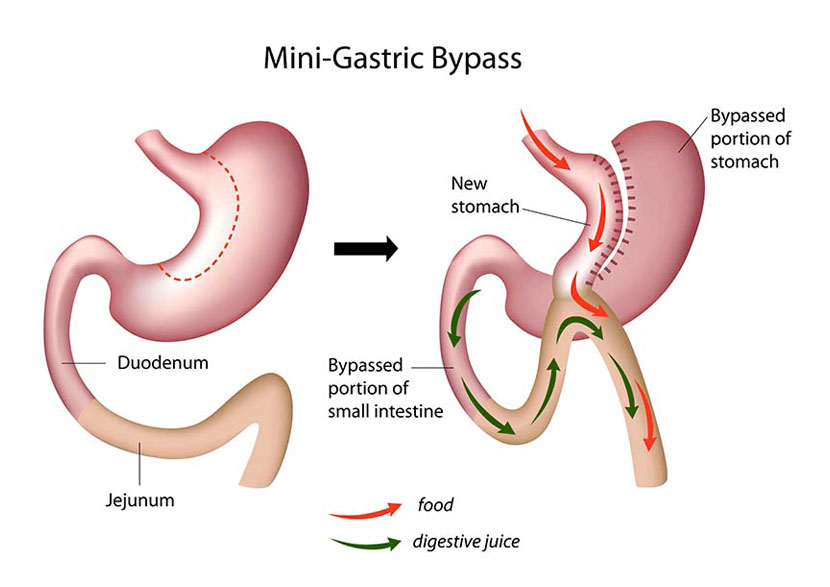While traditional gastric bypass surgery results in excellent weight loss, the procedure is technically challenging and carries a 7% complication risk. The risk of mortality (death) is very low, about 0.5% according to most studies.
The mini-gastric bypass procedure has gained popularity in recent years. The mini-gastric bypass was originally developed by Dr. Robert Rutledge in 1997. The mini-gastric bypass is quicker, technically easier and carries a lower complication rate compared to traditional gastric bypass surgery, 2.9% (2012 MGB study).
The mini-gastric bypass procedure is restrictive and malabsorptive. This means that the procedure reduces the size of your stomach, restricting the amount you can eat. The procedure also reduces absorption of food by bypassing up to 6 feet of intestines. Gastric bypass and the mini-gastric bypass are both malabsorptive and restrictive procedures. Gastric sleeve and the Lap Band are restrictive procedures.
Why Was The Mini-Gastric Bypass Created?
The mini-gastric bypass was developed to reduce operating time, simplify the procedure and reduce complications. Recent studies show that it does reduce operating time, may lead to similar weight loss (some studies show that mini-gastric bypass may actually produce more weight loss), and reduce overall complication rates compared to gastric bypass surgery (Gastric Bypass Compared to Mini-Gastric Bypass).
Why Doesn’t Everyone Choose Mini-Gastric Bypass?
Mini-gastric bypass is currently not covered by most insurance carriers. And there are not enough surgeons trained on this procedure. While more data is showing up that supports the claims that mini-gastric bypass surgery is equal to or slightly better than gastric bypass surgery, there is still not enough data to warrant insurance coverage and mass adoption.
Procedure Information
Mini-gastric bypass is a quicker operation compared to traditional laparoscopic gastric bypass surgery. Operating times are reduced, on average by 50 minutes (Laparoscopic Roux-en-Y Versus Mini-Gastric Bypass for the Treatment of Morbid Obesity).

Mini gastric bypass procedure.
Procedural Steps:
- The stomach is divided with a laparoscopic stapler. Most of the stomach is no longer attached to the esophagus and will no longer receive food. Your new stomach is much smaller and shaped like a small tube.
- Between 2 to 7 feet of intestines are bypassed. The surgeon will attach the remainder of the intestines to the new stomach.
- Food now flows into your small tube-like stomach and then bypasses between 2 to 7 feet of intestines where it resumes the normal digestive process in you’re the remaining intestine.
Benefits of Mini Gastric Bypass Compared to Gastric Bypass Surgery
- Shorter operating time.
- Less re-routing of the intestines.
- One fewer anastomosis (connection of intestines), which in theory means less chance of a complication.
- Technically easier for the surgeon.
- Similar weight loss and recovery.
Additional Risks With Mini-Gastric Bypass Compared To Gastric Bypass
- Severe acid-reflux. Because the pouch is small and the remainder of the stomach is still connected to the intestines. It is possible for gastric juices to travel down the intestines and into the new pouch.
Recovery, Pain and Complications
Recovery, pain and complications are very similar to traditional gastric bypass surgery.
Recovery
After surgery you will have some belly pain, particularly at your incision sites. The incision sites, typically 5, are between 5mm and 12mm in length. This is where the surgeon inserted ports to access your abdomen.
You will typically be required to stay overnight in the hospital. Occasionally patients are kept an additional day for observation.
Once you are home, you’ll be required to follow a strict diet. A liquid diet (soft food) is usually required for the first two weeks after surgery. This may include protein shakes, water, pureed soft foods, and soup. Follow the instructions from your surgeon. After two weeks, soft foods are introduced. And after a month you’ll be back to normal foods. However, you’ll be asked to follow a new diet that will include more protein, vegetables and fruit. Your stomach is much smaller and there is no room for junk food (you need to maximize nutrients from every bite you eat).
Pain
Pain is usually not an issue. Yes, you will be in some pain. This is particularly true during the first two weeks and is very evident when you twist your torso. Pain can be managed well with medication.
You’ll be encouraged to get up and move every day after surgery. The first few days usually include walks around the house. After a week you may be asked to take 20 minute walks twice a day. Gradually increasing exercise is encouraged with each week after surgery. Again, follow your surgeons instructions.
Be prepared to be tired as you lose weight fast and adjust to a lower calorie diet. Fight through this phase. It does pass. A regular exercise routine will help your body adjust.
Complications
Complications are similar to gastric bypass surgery. They range in severity from minor to significant.
Minor complications include hernias at the surgical site, ulcers, and minor incision infections.
Major complications typically occur within the first three weeks after surgery. Significant complications include staple line leaks, pulmonary embolisms, and strictures, among other risks. These should be managed promptly by your surgeon. Before surgery you should be made aware of the risks and signs and symptoms of these complications.
Should You Choose To Have Mini-Gastric Bypass?
It’s difficult to say. And most surgeons have differing opinions on this. Currently, there is not enough data, nor enough surgeons offering the procedure to give a definitive answer. As with all weight loss procedures, discuss this and all of your options with a qualified bariatric surgeon.
